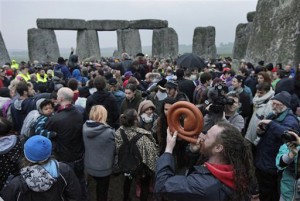
Stonehenge (Photo: Rupert Jones via Flicker/Creative Commons)
As crowds converged on Stonehenge last week for the summer solstice, a new study based on 10 years of archaeological investigations revealed the ancient monument was built to unify all of the people of Britain.
For years, experts have tried to uncover the many mysteries of Stonehenge, one of the world’s most famous prehistoric sites, which was built about 4,500-to- 5,000 years ago in South Central England.
Stonehenge has long been thought to be a prehistoric observatory, a sun temple, a place of healing and a temple of the ancient druids. But a team of archeologists, working on the Stonehenge Riverside Project, rejected all those possibilities.
According to the research team, the Neolithic and Bronze Age structure was built after years of struggle and conflict between the people of eastern and western Britain.
The stones symbolize the ancestors of different farming communities in Great Britain, according to the researchers.
The building of Stonehenge also corresponded with a shift of identity for the British.
“When Stonehenge was built, there was a growing island-wide culture – the same styles of houses, pottery and other material forms were used from Orkney to the south coast,” said Mike Parker Pearson, a member of the Stonehenge Riverside Project. “This was very different to the regionalism of previous centuries. Just the work itself, requiring everyone literally to pull together, would have been an act of unification.”
The construction of Stonehenge required thousands of laborers to move the monolithic stones from as far away as west Wales. Many more people were needed to shape and erect the stones after such a long journey.
Archeologists believe Stonehenge was built in stages from about 3000 BC to 2000 BC.
The location for Stonehenge wasn’t a random choice, according to researchers. The spot had a long-held, special significance to the prehistoric people of Britain.
The research team found that Stonehenge’s collection of stones, which are aligned with the solstices, actually sits on a series of natural landforms that form an axis between the directions of midsummer sunrise and midwinter sunset.
“When we stumbled across this extraordinary natural arrangement of the sun’s path being marked in the land,” says Parker Pearson, “we realized that prehistoric people selected this place to build Stonehenge because of its pre-ordained significance. This might explain why there are eight monuments in the Stonehenge area with solstitial alignments, a number unmatched anywhere else. Perhaps they saw this place as the center of the world”.





 Science World is VOA’s on-air and online magazine covering science, health, technology and the environment.
Science World is VOA’s on-air and online magazine covering science, health, technology and the environment.